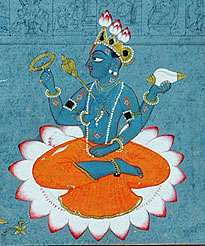Nara-Narayana
Nara-Narayana (Sanskrit: नर-नारायण; nara-nārāyaṇa) is a Hindu deity pair. Nara-Narayana is the twin-brother avatar of the God Vishnu on earth, working for the preservation of dharma or righteousness. Nara narayana are two bodies one soul.They are Avyaktha vishnu bagawan's vyakta roopa.
| Nara Narayana | |
|---|---|
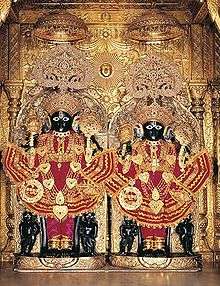 The twin form of Nara Narayana Deva at the Swaminarayan Temple Ahmedabad | |
| Devanagari | नर-नारायण |
| Sanskrit transliteration | nara-nārāyaṇa |
| Affiliation | Avatar of Vishnu |
| Abode | Badrinath |
The Hindu epic Mahabharata identifies the God Krishna (an avatar of Vishnu) with Narayana and Arjuna - the chief hero of the epic - with Nara. The legend of Nara-Narayana is also told in the scripture Bhagavata Purana. Hindus believe that the pair dwells at Badrinath, where their most important temple stands.
The Nara-Narayana pair is frequently worshipped in temples of the Swaminarayan Faith, as the followers of the sect believe that their founder Swaminarayan resides in the murti of Naranarayan Dev in Kalupur Mandir.
Etymology
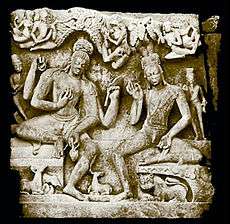
The name "Nara-Narayana" can be broken into two Sanskrit terms, Nara and Narayana. Nara means Human, and Narayana refers to the name of the deity.
Monier-Williams dictionary says Nara is "the primeval Man or eternal Spirit pervading the universe always associated with Narayana, "son of the primeval man"; both are considered either as gods or sages and accordingly called देवौ, ऋषी, तापसौ. In epic poetry, they are the sons of Dharma by Murti or Ahimsa and emanations of Vishnu, Arjuna being identified with Nara, and Krishna with Narayana.- Mahabharata, Harivamsa and Purana".[1] Narayana and Nara both are forms of Vishnu.
Depiction
Nara-Narayana are depicted jointly or separately in images. When depicted separately, Nara is portrayed with two hands and wearing deer skin while Narayana is shown on the right in the usual form of Vishnu.
Sometimes, both of them are depicted identical to each other. They are depicted four-armed holding a mace, a discus, a conch and a lotus, resembling Vishnu.
Legends
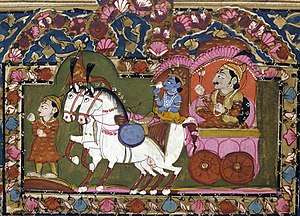
Arjuna and Krishna are often referred to as Nara-Narayana in the Mahabharata and are considered part incarnations of Nara and Narayana respectively, according to the Bhagavata Purana.[2]
In a previous life, the duo were born as the sages Nara and Narayana, and who performed great penances at the holy spot of Badrinath. Nara and Narayana were the Fourth Avatar of Vishnu. The twins were sons of Dharma, the son of Brahma and his wife Murti (Daughter Of Daksha) or Ahimsa.[3] They live at Badrika performing severe austerities and meditation for the welfare of the world. These two inseparable sages took avatars on earth for the welfare of mankind. Legend has it that once Shiva tried to bring the fame of Nara and Narayana before the entire world. To do that, he hurled his own potent weapon Paashupathastra at the meditating rishis. The power of their meditation was so intense that the astra lost its power before them. Shiva stated that this happened since the duo were jnanis of the first order constantly in the state of Nirvikalpa Samadhi.
Birth of Urvashi
The Bhagavata Purana tells the story of the birth of Urvashi from the sages Nara-Narayana.[4] Once, sages Nara-Narayana were meditating in the holy shrine of Badrinath situated in the Himalayas. Their penances and austerities alarmed the gods, so Indra, the King of Devas, sent Kamadeva, Vasanta (spring) and apsaras (nymphs) to inspire them with passion and disturb their devotions. The sage Narayana took a flower and placed it on his thigh. Immediately there sprung from it a beautiful nymph whose charms far excelled those of the celestial nymphs, and made them return to heaven filled with shame and vexation. Narayana sent this nymph to Indra with them, and from her having been produced from the thigh (uru in Sanskrit) of the sage, she was called Urvashi. Having sent back the nymphs back, the divine sages continued to meditate. [5][6]
Badrinath
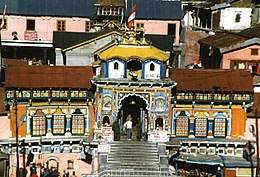
According to the Bhagavata purana, "There in Badrikashram (Badrinath) the Personality of Godhead (Vishnu), in his incarnation as the sages Nara and Narayana, had been undergoing great penance since time immemorial for the welfare of all living entities." (3.4.22)
In Badrinath Temple's sanctorium, to the far right side of the stone image of Badri-Vishala (or Badri-Narayana), are the images of Nara and Narayana. Also, the Nara and Narayana peaks tower over Badrinath.
Mahabharata

According to Bhandarkar, the gods Nara-Narayana must have been very popular at the time of the composition of the Mahabharata, since in the opening stanzas of various parvas (constituent books) of the epic, obeisance is made to these two gods. In Vanaparvan (12. 46, 47), Krishna says to Arjuna,"O invincible one, you are Nara and I am Hari Narayana, and we, the sages Nara-Narayana, have come to this world at the proper time.." In the same Parva, chapter 40 (verse 1); Shiva says to Arjuna — "In former birth you were Nara and with Narayana as your companion, performed austerities for thousands of years at Badari".[7]
Swaminarayan sect
In the Swaminarayan sect, Nara and Narayana, are called Nara-Narayana Deva. They are believed to reside at Badrikashram and to be the prime controllers of the destiny of all beings, depending on their karma. Nara-Narayana Deva are believed to have manifested at Narayana Ghat on the banks of river Sabarmati at Ahmedabad. Therefore, their images were installed by Swaminarayan at the first Swaminarayan temple, Swaminarayan Mandir, Ahmedabad (India).
Members of this group interpret the events that took place at Badarikashram, the abode of Nara Narayana, that led to the incarnation of Swaminarayan. They believe that Narayana took birth as Swaminarayan due to a curse of sage Durvasa which he accepted at his own will. The curse led to Narayana taking the form of an avatar on Earth to destroy evil and establish ekantik-dharma, religion based on morality, knowledge, detachment and devotion.[8]
See also
| Part of a series on |
| Vaishnavism |
|---|
 |
|
Holy scriptures
|
|
Sampradayas
|
|
Related traditions |
|
|
| Wikimedia Commons has media related to Nara Narayana. |
Notes
- Vijnanananda 2004, p. 250
- According to Vamana Purana, Chapter 6 - Bhandarkar p.46
- The Goddess in India: The Five Faces of the Eternal Feminine By Devdutt Pattanaik, Published 2000, Inner Traditions / Bear & Company, 176 pages, ISBN 0-89281-807-7 p.66
- Tales from the Puranas By Mahesh Sharma, pp.60-62, Diamond Pocket Books (P) Ltd.,ISBN 81-288-1040-5
- Vijnanananda 2004, pp. 267–272
- "The Mahabharata, Book 3: Vana Parva: Kairata Parva: Section XL". www.sacred-texts.com. Retrieved 11 December 2019.
- "History of Incarnation of Lord Shree Swaminarayan". Archived from the original on 10 September 2009.
References
- Bhandarkar, Ramkrishna Gopal (1995). Vaisnavism Saivism and Minor Religious Systems. Asian Educational Services. p. 238. ISBN 81-206-0122-X.CS1 maint: ref=harv (link)
- Vijnanananda, Swami (2004). The Sri Mad Devi Bhagavatam: Books One Through Twelve Part 1. Kessinger Publishing. p. 624. ISBN 0-7661-8167-7.CS1 maint: ref=harv (link)
- Swaminarayan Temple Cardiff - Murtis - NarNarayan Dev
